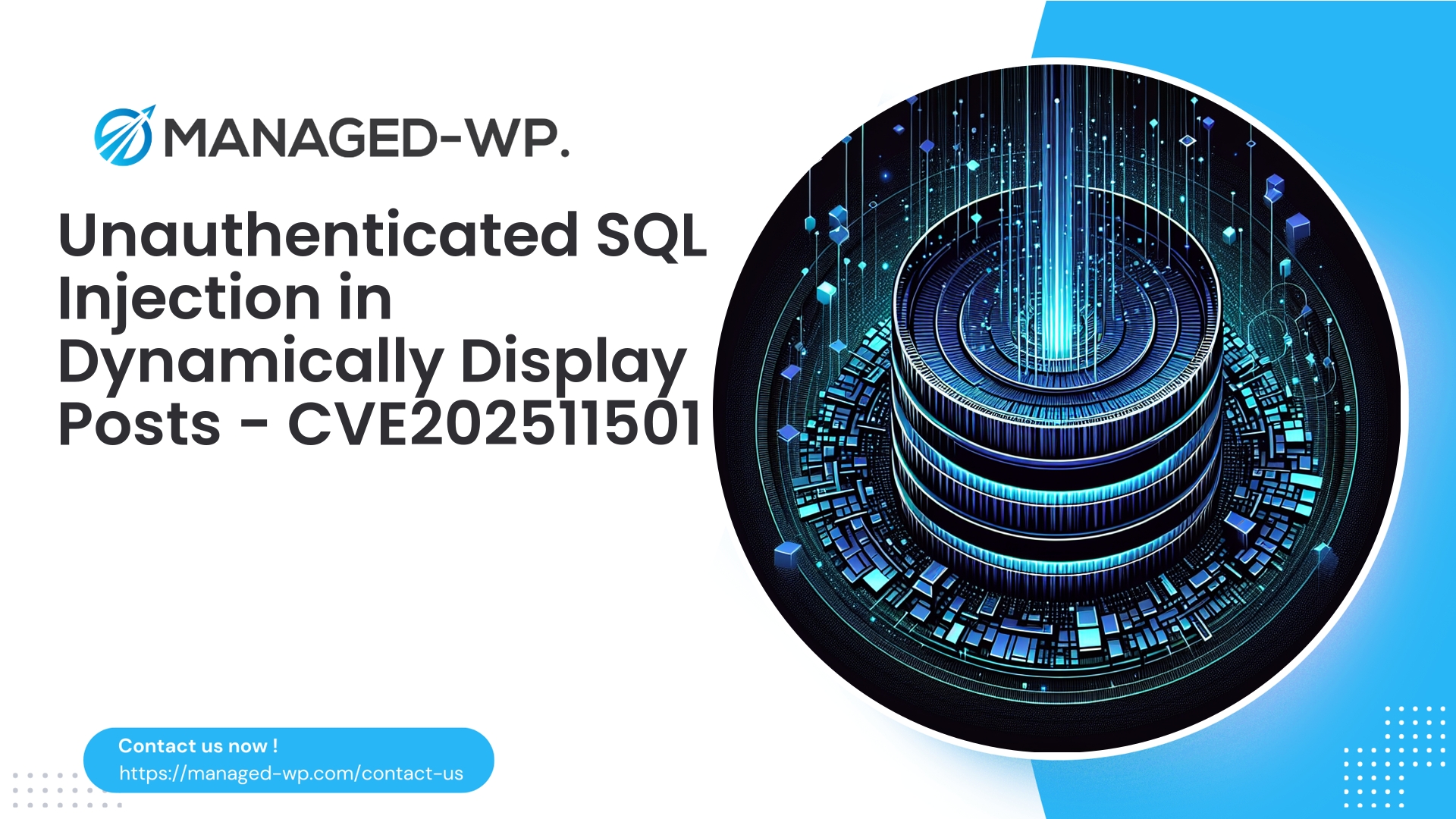| 插件名稱 | 動態顯示帖子 |
|---|---|
| 漏洞類型 | SQL注入 |
| CVE編號 | CVE-2025-11501 |
| 緊急 | 高的 |
| CVE 發布日期 | 2025-10-15 |
| 來源網址 | CVE-2025-11501 |
緊急安全性公告: 「動態顯示貼文」功能(版本≤1.1)存在嚴重的未經驗證的 SQL 注入漏洞
發布日期: 2025年10月15日
CVE 參考編號: CVE-2025-11501
研究資料來源: 宋大亞
如果您的 WordPress 環境中運行的是 1.1 或更早版本的「Dynamically Display Posts」插件,則必須立即採取措施。 Managed-WP 的安全專家發現該外掛程式存在一個嚴重的未經驗證的 SQL 注入漏洞 (CVE-2025-11501)。此漏洞允許未經身份驗證的攻擊者篡改資料庫查詢,從而造成資料竊取、網站篡改甚至伺服器完全被攻破的嚴重風險。
此漏洞的 CVSS 評分為 9.3,截至本公告發佈時,尚未發布官方修補程式。 Managed-WP 致力於為您提供及時、權威的指導,幫助您了解風險、檢測利用嘗試,並立即實施有效的遏制和緩解措施。
目錄
- 執行摘要
- 為什麼這漏洞需要緊急關注
- 範圍:哪些人面臨風險?
- 技術概述(摘要)
- 潛在攻擊載體和利用途徑
- 偵測策略:識別剝削跡象
- 網站所有者應立即採取的措施(按優先順序排序)
- 利用Web應用程式防火牆和虛擬補丁
- Managed-WP 建議的 WAF 規則概念
- 疑似入侵事件回應檢查清單
- 插件開發者指南和安全編碼
- WordPress長期安全最佳實踐
- 常見問題解答
- Managed-WP Protection(免費方案)入門指南
- 結論和補充參考文獻
執行摘要
「動態顯示貼文」外掛程式(1.1 及更早版本)存在一個嚴重漏洞,允許攻擊者在未經身份驗證的情況下進行 SQL 注入。該漏洞允許攻擊者在沒有任何登入憑證的情況下,將惡意 SQL 命令注入到插件產生的資料庫查詢中,從而導致敏感資料被非法存取、內容被篡改,甚至整個網站被完全控制。
- 受影響版本:≤ 1.1
- 身份驗證:無需
- 補丁狀態:尚未發布官方補丁
- CVE編號:CVE-2025-11501
- 嚴重程度:高(CVSS 9.3)
該漏洞的公開意味著自動化掃描和利用攻擊很可能在受影響的網站上迅速蔓延。因此,迅速採取緩解措施至關重要。
為什麼這漏洞需要緊急關注
SQL注入仍然是最具破壞性的Web應用程式漏洞之一。此問題尤其危險,原因如下:
- 未經認證的向量: 攻擊者無需任何有效的使用者憑證即可進行攻擊。
- 敏感資料外洩: 利用該漏洞可能會洩漏使用者資訊、密碼雜湊值、電子郵件,甚至可能洩露 API 令牌。
- 數據處理: 攻擊者可以修改或刪除網站內容、插入管理後門或建立未經授權的帳戶。
- 升級可能性: 擁有過高的資料庫權限,攻擊者可能會執行作業系統指令或提升控制權限。
- 自動化攻擊風險: 這種高影響力的漏洞會被迅速利用,進行廣泛的掃描和攻擊。
即使是像「動態顯示貼文」這樣看似簡單的插件,如果資料庫查詢中沒有安全地處理使用者輸入,也可能無意中暴露出嚴重的安全漏洞。
範圍:哪些人面臨風險?
- 所有安裝了「動態顯示文章」版本 1.1 或更早版本的 WordPress 安裝。
- 公開此外掛程式產生的短代碼、AJAX 端點或 REST API 路由的網站。
- 在具有預設或過於寬鬆的 WordPress 資料庫權限的環境中進行安裝。
網站管理員和主機服務提供者應立即清點其資產,尋找受影響的外掛程式版本。
技術概述(摘要)
此漏洞的產生是因為該外掛程式將使用者提供的輸入直接拼接成 SQL 語句,而沒有進行適當的參數化或清理。這種缺乏預處理語句或安全 ORM 實踐的做法,使得攻擊者能夠注入任意 SQL 程式碼。
筆記: Managed-WP 不會公開分享漏洞利用程式碼或完整的有效載荷,以最大限度地降低風險,而是專注於防禦指導。
- 將 HTTP GET/POST 輸入直接連接成 SQL 字串是不安全的。
- 缺少 $wpdb->prepare 或類似的 WordPress 資料庫安全機制。
- 透過公共短代碼、AJAX 或 REST 介面進行暴露,而無需進行能力檢查。
- 輸入過濾和驗證假設寬鬆。
潛在攻擊載體和利用途徑
- 公用短代碼屬性或 URL 查詢參數,用於輸入 SQL 篩選器或排序子句。
- 類似 /wp-admin/admin-ajax.php 的 AJAX 端點接受未經清理的過濾參數。
- 插件實作的 REST API 路由,用於傳回動態查詢結果。
- 對影響 SQL 命令建構的查詢字串變數進行操作。
威脅行為者的攻擊流程可能包括偵察以驗證插件是否存在,然後有針對性地精心建構請求以利用 SQLi 漏洞並存取或修改資料。
偵測策略:識別剝削跡象
應用層指標(日誌和回應)
- Web 伺服器日誌中出現異常長、格式錯誤或可疑的查詢參數。
- 在HTTP回應或錯誤日誌中可以看到SQL或資料庫錯誤訊息。
- 披露後不久,針對插件相關端點的請求頻率顯著增加。
- 回應內容與預期格式不符,例如,洩漏使用者資料或原始資料庫內容。
資料庫和內容指標
- 意外新增的管理員或編輯帳號。
- 未經授權對貼文、頁面或網站選項進行更改。
- 在貼文或留言中註入惡意內容。
- WordPress 自訂表格或選項中存在可疑條目。
伺服器指標
- 伺服器發起的出站連線或意外網路活動。
- 外掛目錄或上傳目錄中出現新檔案。
- CPU 使用率或資源使用率異常飆升,表示有漏洞活動。
如果發現任何此類跡象,則認為受影響的網站已受到攻擊,並遵循以下事件回應指南。
網站所有者應立即採取的措施(按優先順序排序)
- 受影響的庫存地點: 找到所有安裝了存在漏洞的插件的實例,並記錄版本資訊。
- 停用或移除外掛程式: 如果可能,請先停用或卸載插件,直到問題修復為止。如果管理員權限被洩露,請透過 FTP 或 SSH 重新命名插件目錄。
- 透過 WAF 啟用虛擬補丁: 應用 Web 應用程式防火牆規則,阻止針對外掛程式參數和端點的 SQL 注入嘗試。
- 限制存取: 使用伺服器或外掛程式層級的控制來阻止對易受攻擊的頁面、AJAX 端點或 REST 路由的公共存取。
- 建立備份快照: 進行離線備份,並儲存備份檔案以備必要時進行取證分析。
- 輪換所有憑證: 如果懷疑系統遭到入侵,請變更資料庫密碼、API 金鑰、WordPress 管理員密碼並使會話失效。
- 啟用警惕日誌記錄: 增加日誌記錄的詳細程度,並監控異常請求或攻擊嘗試。
- 制定並實施官方修復方案: 官方補丁發布後,請立即應用並進行徹底測試。
如果插件必不可少且無法立即移除,則應專注於 WAF 虛擬修補和存取限制,以降低風險。
利用Web應用程式防火牆和虛擬補丁
WAF 可以作為您的第一道防線,在惡意負載到達易受攻擊的程式碼之前將其攔截,並在官方更新發布之前提供虛擬修補程式。
- 無需修改網站代碼。
- 快速部署和可擴充性。
- 阻止自動化攻擊嘗試並減少攻擊面。
- 為有序部署補丁爭取時間。
Managed-WP 的規則集針對可疑的參數模式、異常的 SQL 語法、掃描行為和已知的易受攻擊的端點,提供專門針對此漏洞調整的分層保護。
重要的: 虛擬修補是一種臨時緩解措施,必須輔以適當的修補或插件移除。
Managed-WP 建議的 WAF 規則概念
- 封鎖已知外掛程式查詢參數中的 SQL 元字元(例如,註解、引號、分號)。
- 對頻繁或重複嘗試攻擊的 IP 位址進行限流或屏蔽。
- 部署基於 IP 和地理位置的威脅情報,以質疑或阻止可疑來源。
- 檢查 AJAX 和 REST 有效負載,阻止異常或意外內容。
- 拒絕有效負載格式或大小不符合預期的請求。
- 禁止在HTTP回應中顯示詳細的資料庫錯誤訊息。
這些規則應進行調整,以平衡防護能力和誤報率。 Managed-WP 可以提供量身訂製、可立即部署的防護方案。
疑似入侵事件回應檢查清單
- 隔離: 暫時關閉網站或封鎖公共流量,以防止進一步損害。
- 保存證據: 保留備份、日誌和取證資料快照。
- 掃描與分析: 識別未經授權的代碼、帳戶或修改。
- 更改憑證: 重設所有密碼、API令牌,並使會話失效。
- 移除惡意程式碼: 手動或在專業人員的協助下清除後門和未經授權的使用者帳戶。
- 恢復已知良好狀態: 緩解和修補後,從乾淨的備份中恢復。
- 重建與強化: 從可信任來源重新安裝核心和插件,重新應用安全措施。
- 溝通: 如資料保護法律適用,則通知受影響的使用者或利害關係人。
- 事後分析: 記錄調查結果和經驗教訓,並改善修補和監控流程。
插件開發者指南和安全編碼
為消除 SQL 注入風險,開發人員必須遵循最佳實踐,包括:
- 使用 WordPress 的 $wpdb->prepare 來準備所有涉及使用者輸入的資料庫查詢。
- 切勿將未經檢查的輸入直接連接到 SQL 字串中。
- 儘早驗證和清理輸入,通常使用允許清單。
- 對改變行為的端點加入隨機數和能力檢定。
- 對所有輸出進行清理,避免洩漏內部錯誤訊息。
- 僅允許公共端點傳輸必要數據,並考慮對敏感功能進行身份驗證。
- 實施全面的單元測試和整合測試,以涵蓋惡意輸入嘗試。
- 遵循負責任的披露協議,並在發布補丁時發布清晰的變更日誌。
遵循這些標準是保護使用者和更廣泛的 WordPress 生態系統的關鍵。
WordPress長期安全最佳實踐
- 保持準確的庫存清單,並及時刪除不活躍的外掛程式和主題。
- 對資料庫和伺服器帳戶採用最小權限原則。
- 實施定期異地備份程序,並配備經過測試的復原流程。
- 強制所有管理者使用者使用強密碼和多因素身份驗證。
- 限制管理員帳戶數量並監控使用模式。
- 盡可能為非關鍵元件啟用自動更新,並維護測試環境以安全地測試修補程式。
- 利用持續監控解決方案來偵測文件完整性、流量異常和可疑的資料庫查詢。
- 保留日誌足夠長的時間,以便進行詳細調查。
常見問題 (FAQ)
Q:Managed-WP能否自動保護我的網站免受此漏洞的侵害?
答:當然。 Managed-WP 透過我們託管的 WAF 提供虛擬修補功能,當您更新或移除有漏洞的外掛程式時,可以阻止已知的攻擊嘗試。
Q:我應該立即刪除該插件嗎?
答:如果外掛程式並非網站必需,在官方發布修復修補程式之前,停用或移除它是最安全的做法。如果外掛程式對網站功能至關重要,則必須立即採取有效的虛擬修補措施和存取限制。
Q:如果我已經發現可疑活動怎麼辦?
答:假定資訊已洩露,並啟動上述事件回應計畫。考慮尋求專業人士的協助,進行徹底的取證分析和復原工作。
Q:啟用防火牆能否消除所有風險?
答:WAF(網路應用防火牆)透過攔截常見攻擊顯著降低安全風險,但並不能取代官方更新或外掛程式移除。虛擬補丁是一種有效的過渡措施。
立即使用 Managed-WP 免費規劃,開始保護您的網站安全
我們強烈建議所有網站所有者立即採取安全措施。 Managed-WP 提供易於使用的免費保護方案,其中包括:
- 基礎版(免費): 託管防火牆,具備必要的 Web 應用防火牆 (WAF) 規則、惡意軟體掃描功能,並能抵禦常見的 Web 漏洞。可立即進行虛擬修補更新和自動威脅偵測。
- 標準($50/年): 基本功能外加自動惡意軟體清除和 IP 允許/拒絕管理。
- 專業版($299/年): 進階報告、針對新漏洞的自動虛擬修補以及進階託管服務。
立即保護您的網站: https://my.wp-firewall.com/buy/wp-firewall-free-plan/
需要協助選擇合適的方案或評估風險嗎? Managed-WP 的專家隨時準備為您提供協助。
結論
「動態顯示文章」功能(≤ v1.1)中的此 SQL 注入漏洞對 WordPress 網站構成重大威脅。鑑於該漏洞影響巨大且未經身份驗證,必須迅速採取分層應對措施。
Managed-WP 的安全團隊建議:
- 立即檢查您的 WordPress 安裝,查看受影響的外掛程式版本。
- 盡可能停用或移除插件。
- 如果暫時無法移除,則立即部署虛擬修補程式和存取控制。
- 保持高度警惕,做好監控和備份工作,如果出現任何可疑活動,請遵循事件處理規程。
如需協助進行識別、虛擬修補程式部署或事件恢復,請造訪: Managed-WP 免費計劃.
保持警惕。
Managed-WP 安全團隊
參考文獻及延伸閱讀
- CVE-2025-11501 官方 CVE 紀錄
- 外掛作者和 WordPress.org 公告頁面提供更新和補丁信息
免責聲明:本安全建議由 Managed-WP 的安全專家提供。我們不發布漏洞程式碼,而是專注於提供實用有效的防禦指導,以保護 WordPress 社群的安全。



















